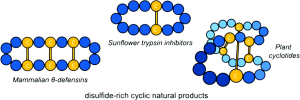Bioactive peptides have potential as drug leads. However, one of the peptides’ limitations is their poor stability.
One solution is to graft peptides onto suitable molecular scaffolds. When the peptide scaffolds are rich in disulfide bonds and have no free ends for proteases to attack, the peptide drug would be a stable candidate.
Cyclic disulfide-rich peptides: Stability Matters
Many natural peptides have stable and conserved cyclization. The cyclic chlorotoxin can preferentially bind to tumor cells. The defensin, an antimicrobial peptide, is an 18 amino acid peptide with three disulfide bonds in a laddered arrangement. The cyclotide has about 30 amino acids with three disulfide bonds in a knotted configuration. The cyclic conotoxin cVc1.1 has potent analgesic activity.

disulfide-rich cyclic natural product
Molecular grafting
Molecular grafting aims to make a linear peptide sequence into a disulfide-rich peptide with the desired stability or oral bioavailability. It was found that the stability of linear peptide epitopes in human serum can be enhanced by grafting them onto a stable scaffold. For example, a crafted peptide comprising an epitope from myelin oligodendrocyte glycoprotein (MOG) is resistant to degradation in human serum (>24 h) and remains intact in strong acid after 24 hours. In the MOG study, the epitope was grafted into the β-turn of Kalata B1 to mimic its native conformation. It turned out to have increased bioactivity and improved affinity and receptor selectivity. A grafted peptide based on the cell-penetrating cyclotide MCoTI-I demonstrated the delivery of the bioactive peptide across the cell membrane and into the intracellular space.

Cyclotide Peptide Synthesis
How to make molecular grafting
1. Selection of a suitable epitope and scaffold pair. The termini of the epitope should not be essential for its activity. The size of the epitope is a critical consideration. Epitopes ranging from 10 amino acids to 20 amino acids are frequently used. Here are a few examples of the epitope size from the disulfide-rich peptide scaffolds by chemical design: cyclic conotoxin (6 amino acids), defensin (6, 7, or 12 amino acids), Kalata B1 (3, 6, or 9 amino acids), McoTI (3, 7, 9, 16, 18, or 21 amino acids), Cyclic chlorotoxin (10 amino acids).
2. Structural and functional characterization.
The peptide epitope should be from the fragments of an interacting protein or functional and bioactive known domains from the screening assays, such as a phage display library.
Then, where should the epitope be grafted onto the scaffold? There are a few possible suggestions: insertion between two existing residues, substitution of one or more residues in a single loop, replacement of residues that span across connected loops, or replacement of most of the native residues of the scaffold.
3. How to make the grafted peptides?
The grafted peptides have been made using solid-phase chemical peptide synthesis. First, the reduced linear precursors are assembled. They are the sequences from the scaffold and epitope. Then, oxidization and cyclization are performed to form the final product. However, synthesizing more complex peptides with multiple disulfide bonds can be challenging. A peptide comprising just three disulfide bonds would have 15 different connectivities. In addition, grafting of an epitope onto a scaffold may not be folded correctly, or it does not have the desired activity.
Future perspectives
It is encouraging that many grafted peptides have exhibited oral activity. The cyclic disulfide-rich scaffolds have enhanced stability. However, not all grafted peptides fold into the desired conformation. So, a more detailed understanding of how grafting affects the folding of disulfide-rich peptides would be beneficial.
https://doi.org/10.1038/s41589-018-0039-y

disulfide formation
